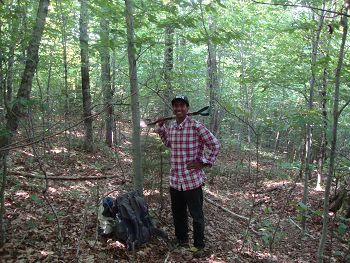Critical Zone Profile - JUSTIN RICHARDSON (Soil biogeochemist, post-doctoral researcher)
Justin grew up playing in the Alfisols and coastal sage scrub of Riverside County, Southern California. He completed his B.S. in Environmental Science with emphasis on Soil Science with a minor in Botany and Plant Sciences at the University of California, Riverside in 2010. With a budding interest in biogeochemistry, Justin pursued a PhD at Dartmouth College in New Hampshire. He currently resides at Cornell University as the Critical Zone National Office Post-Doctoral Fellow. His research encompasses many aspects of trace metal biogeochemistry, including but not limited to soils, trees, and earthworms.
"As a soil biogeochemist, my research focuses on how elements move between the non-living and living components of soil." - Justin Richardson
This ranges from the uptake of nutrients by vegetation, toxic metals by organisms, and accumulation during soil formation. My current research at the Critical Zone Observatory National Office will focus on the fate and transport of Aluminum in soil. Aluminum can be toxic to fish and trees at high concentrations, but Al is also important for the development of secondary minerals during soil genesis. I plan to use Gallium as a pseudo-isotope to understand where and how much Al moves into vegetation and secondary minerals.
Aluminum has been primarily of interest due to its toxicity to plants and animals. At high concentrations, Al has been found to disrupt oxygen uptake in sensitive fish such as trout. In addition, Al reduces root growth in plant and can negatively affect commercially important trees, such as sugar maple in the northeastern United States and corn in tropical, equatorial countries.
The ability to collaborate and work with scientists at many different institutions is an advantage of the connected network of CZOs.
The use of data and samples provided from multiple-CZOs will help me to address how Al moves through the terrestrial ecosystem during soil development. The innovative approach of the Critical Zone Observatory Network presents a true opportunity to assemble the pieces together in a manner that hasn’t been done before. I can share and utilize data from other researchers to get a complete understanding far better than could be accomplished as an individual researcher.
The critical zone is what sustains terrestrial ecosystems; it is where the raw materials of the earth are recycled into new forms for flora and fauna. If we do not understand how it works, we are liable to cause irreparable damage. In addition, we can better evaluate how it to protect the terrestrial ecosystems.
The Critical Zone Observatories are the way forward to be able to assess and link the hydro-biogeochemical systems. It is essential that data from across all of the critical zones are able to be synthesized to quantify how long-term and large-scale processes occur. The climatic and temporal gradients studied at multiple CZOs are needed to detect how a warmer, colder, drier, or wetter environment will influence terrestrial biogeochemistry.
Justin hiking Mount Madison in New Hampshire for samples.
Justin Richardson
Related News
Explore Further






